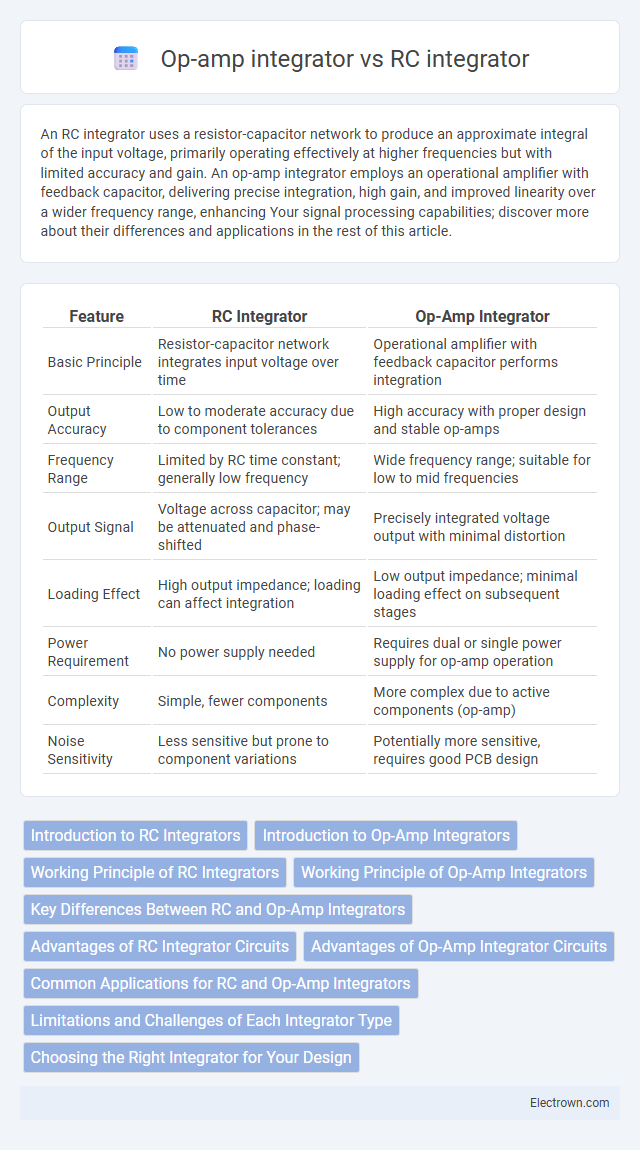An RC integrator uses a resistor-capacitor network to produce an approximate integral of the input voltage, primarily operating effectively at higher frequencies but with limited accuracy and gain. An op-amp integrator employs an operational amplifier with feedback capacitor, delivering precise integration, high gain, and improved linearity over a wider frequency range, enhancing Your signal processing capabilities; discover more about their differences and applications in the rest of this article.
Table of Comparison
| Feature | RC Integrator | Op-Amp Integrator |
|---|---|---|
| Basic Principle | Resistor-capacitor network integrates input voltage over time | Operational amplifier with feedback capacitor performs integration |
| Output Accuracy | Low to moderate accuracy due to component tolerances | High accuracy with proper design and stable op-amps |
| Frequency Range | Limited by RC time constant; generally low frequency | Wide frequency range; suitable for low to mid frequencies |
| Output Signal | Voltage across capacitor; may be attenuated and phase-shifted | Precisely integrated voltage output with minimal distortion |
| Loading Effect | High output impedance; loading can affect integration | Low output impedance; minimal loading effect on subsequent stages |
| Power Requirement | No power supply needed | Requires dual or single power supply for op-amp operation |
| Complexity | Simple, fewer components | More complex due to active components (op-amp) |
| Noise Sensitivity | Less sensitive but prone to component variations | Potentially more sensitive, requires good PCB design |
Introduction to RC Integrators
RC integrators use a resistor-capacitor network to approximate the integral of an input signal by producing an output voltage proportional to the accumulated charge on the capacitor. These simple circuits are commonly employed in analog signal processing for low-frequency integration but suffer from limited accuracy and bandwidth due to component tolerances and leakage currents. In contrast, op-amp integrators leverage operational amplifiers with feedback capacitors to achieve precise and stable integration with higher input impedance and improved linearity across a wider frequency range.
Introduction to Op-Amp Integrators
Op-amp integrators utilize operational amplifiers to perform precise mathematical integration of input signals, providing higher accuracy and stability compared to basic RC integrators. Your circuits benefit from the op-amp's high gain and low input bias current, allowing for improved signal integration over a wide frequency range. These integrators are essential in analog signal processing, filtering, and waveform generation applications where exact time-domain integration is required.
Working Principle of RC Integrators
RC integrators operate by using a resistor-capacitor network to approximate the integral of an input signal, where the capacitor voltage changes proportionally to the time integral of the input current. The input signal passes through the resistor, charging the capacitor, and the output voltage develops across the capacitor, effectively smoothing or integrating rapid voltage changes. This passive circuit fundamentally relies on the time constant defined by the RC product, influencing the integration accuracy and frequency response.
Working Principle of Op-Amp Integrators
Op-amp integrators operate by using the feedback capacitor to accumulate input voltage over time, producing an output proportional to the integral of the input signal. The input resistor converts the input voltage into current, which charges or discharges the feedback capacitor, causing the output voltage to change linearly in response to the input. This arrangement provides precise integration with high gain and low distortion, outperforming simple RC integrators in accuracy and stability.
Key Differences Between RC and Op-Amp Integrators
RC integrators use a resistor and capacitor to produce a basic integration of input signals, limited by signal amplitude and frequency range, while Op-amp integrators incorporate an operational amplifier providing higher precision, gain control, and improved linearity. RC integrators are passive and do not provide amplification, making them suitable for simple, low-frequency applications; Op-amp integrators actively amplify the integrated signal, enabling better performance in complex circuits. Your choice depends on required accuracy, signal strength, and bandwidth, with Op-amp integrators offering greater flexibility and stability for advanced analog signal processing.
Advantages of RC Integrator Circuits
RC integrator circuits offer simplicity and low cost, making them ideal for basic signal processing tasks in low-frequency applications. Their passive components provide inherent stability without the need for power supplies, reducing noise and distortion compared to active op-amp integrators. RC integrators also exhibit high reliability and ease of implementation in compact analog filter designs.
Advantages of Op-Amp Integrator Circuits
Op-amp integrator circuits offer higher accuracy and stability compared to RC integrators due to their low output impedance and high input impedance, minimizing signal loss and loading effects. They provide a wider dynamic range and linear integration over a broader frequency band, ensuring precise waveform integration without drift or distortion. The feedback mechanism in op-amp integrators allows for adjustable gain and integration time constants, enhancing design flexibility in analog signal processing applications.
Common Applications for RC and Op-Amp Integrators
RC integrators are commonly used in signal conditioning circuits, filter design, and waveform generation where simplicity and low cost are essential. Op-amp integrators excel in precise analog computing, active filter design, and analog-to-digital conversion due to their higher accuracy and linearity. Your choice depends on the application's accuracy requirements and circuit complexity.
Limitations and Challenges of Each Integrator Type
RC integrators face limitations such as frequency-dependent accuracy loss and signal attenuation at high frequencies due to passive components. Op-amp integrators encounter challenges including offset voltage drift, input bias currents causing output errors, and limited slew rate that restricts high-frequency response. Both integrator types require careful design consideration to minimize error sources and maintain signal integrity in precision applications.
Choosing the Right Integrator for Your Design
Choosing the right integrator for your design depends on factors such as precision, frequency response, and component tolerance. RC integrators offer simple implementation and cost-effectiveness for low-frequency applications but suffer from drift and limited accuracy. Op-amp integrators provide higher precision, adjustable gain, and better stability, making them ideal for complex signal processing tasks in your electronic circuits.
RC integrator vs Op-amp integrator Infographic

 electrown.com
electrown.com